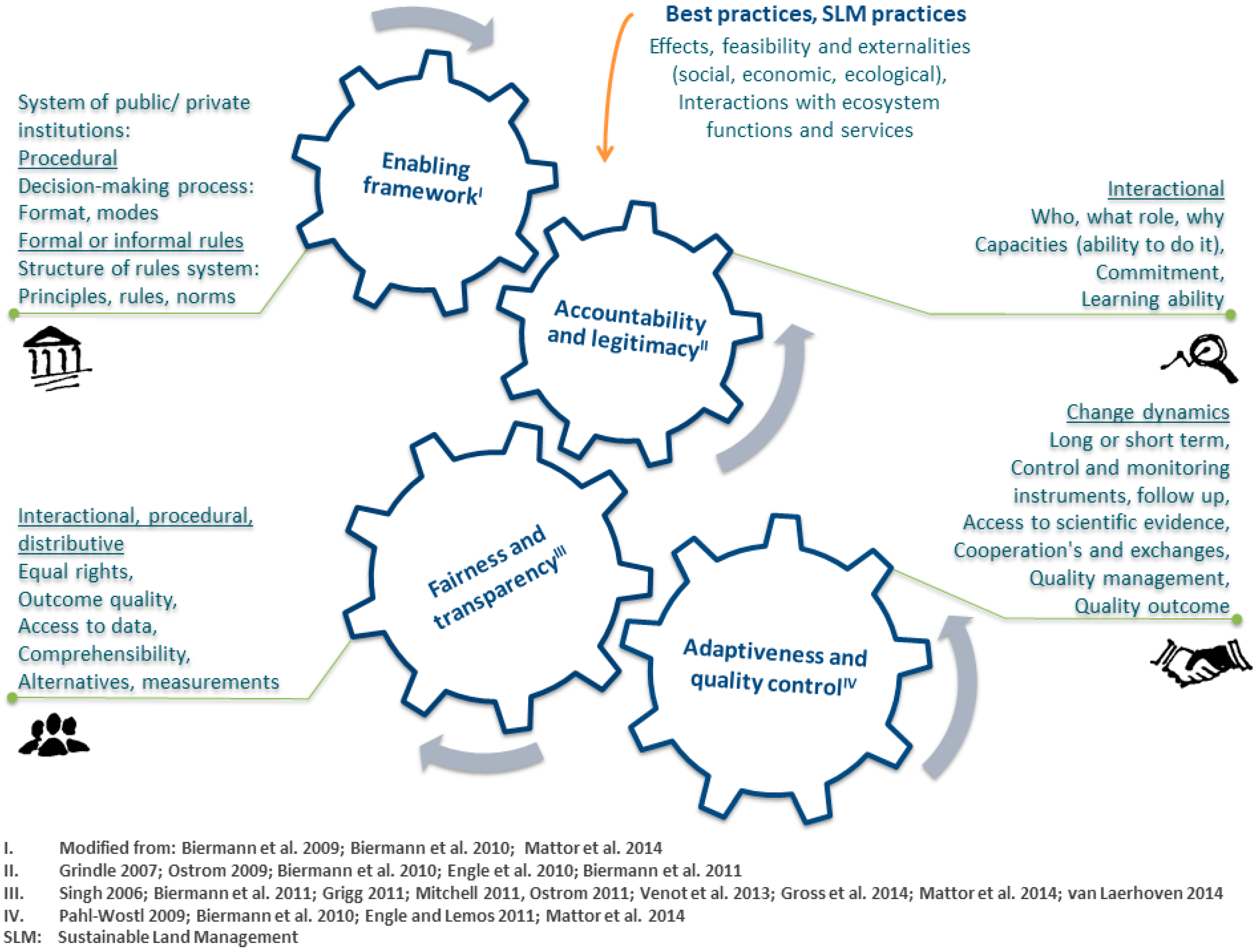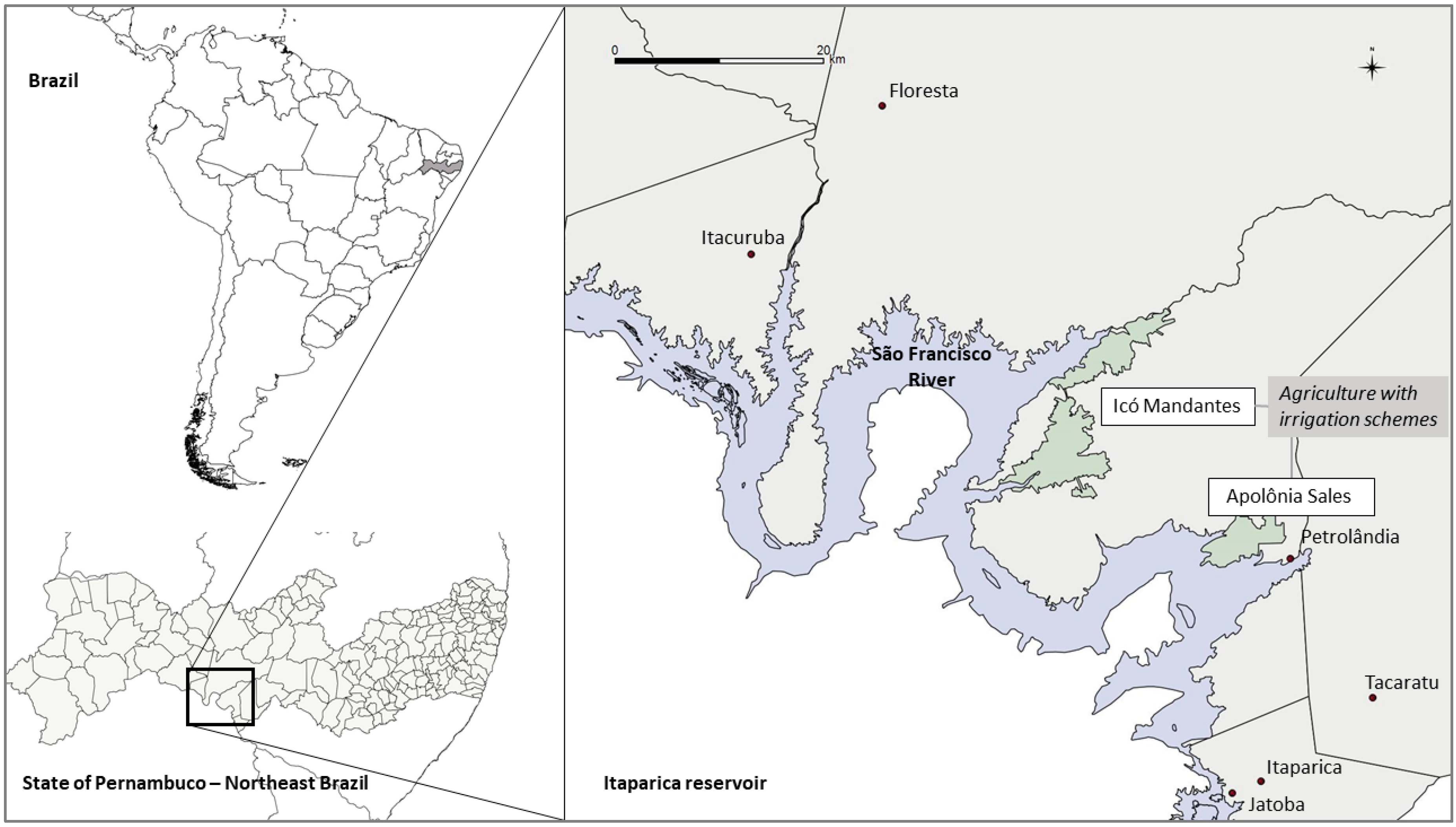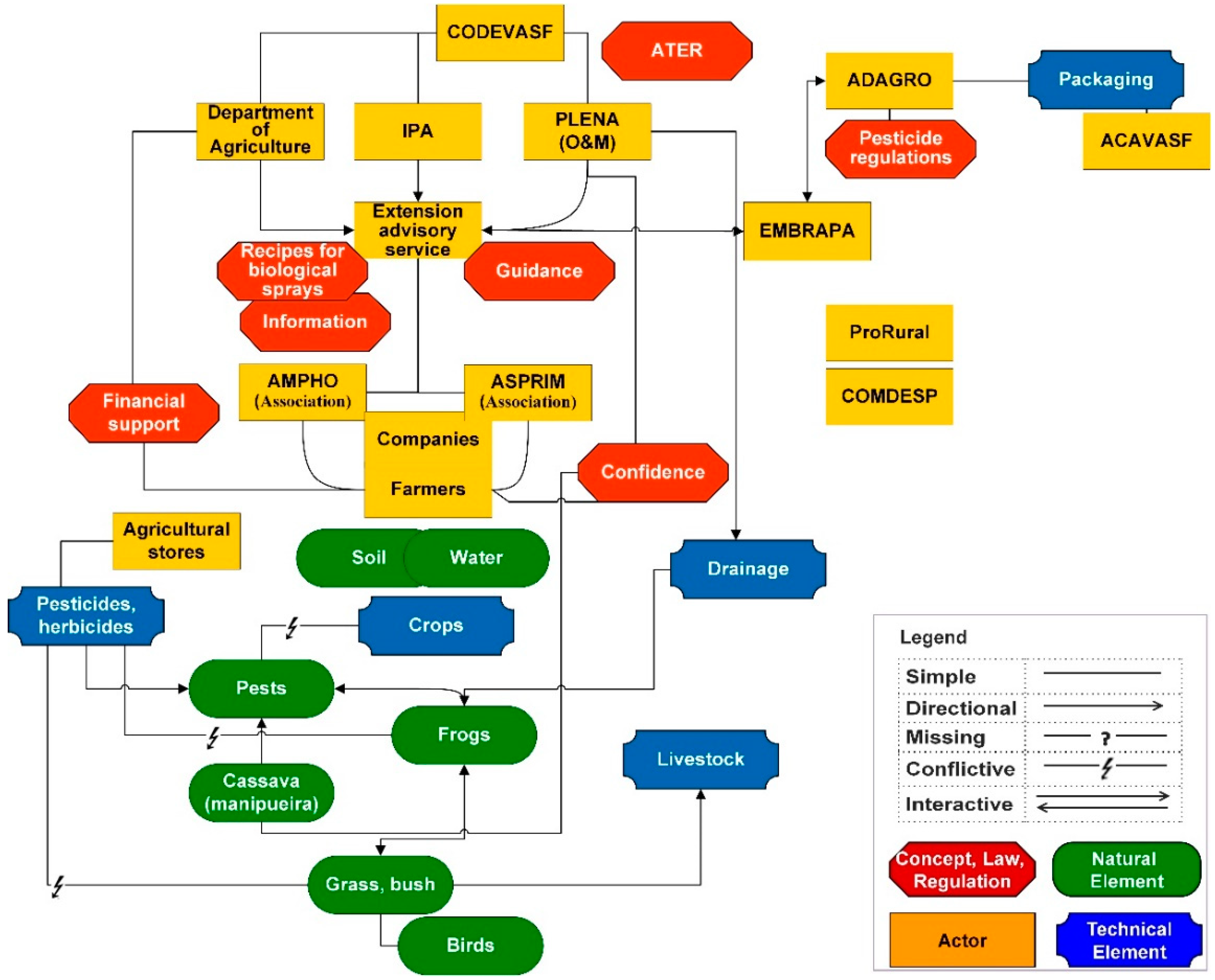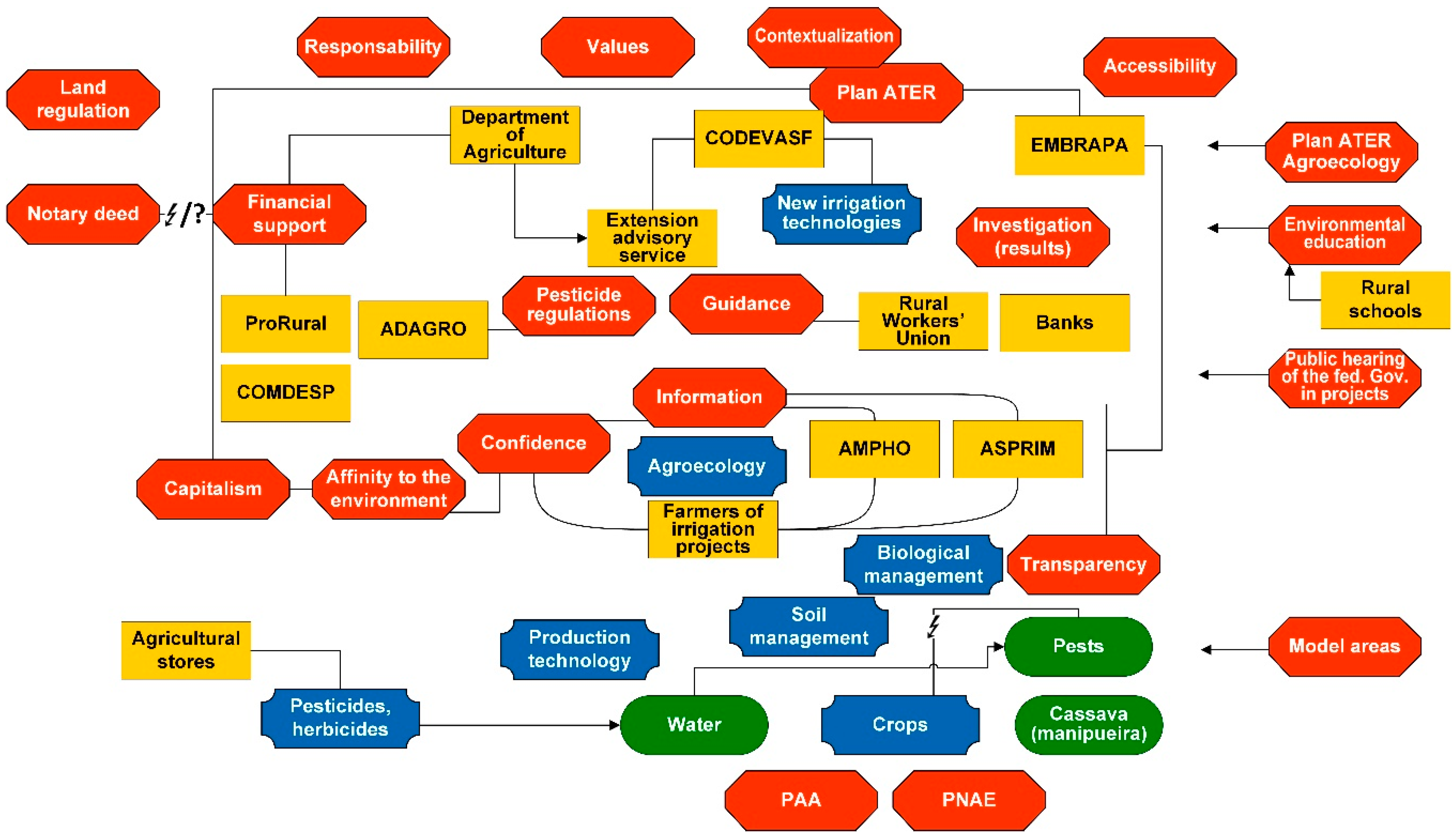Good Governance: A Framework for Implementing Sustainable Land Management, Applied to an Agricultural Case in Northeast-Brazil
Abstract
1. Introduction
2. Literature Review
2.1. The SLM Practice: Biological Pest Control in Irrigated Farming
2.2. Good Governance Attributes for Implementing SLM Practices
2.2.1. Enabling Framework
2.2.2. Accountability and Legitimacy
- Normative: There are sufficiently clarified norms of behavior;
- Relational: There is a connection between those who demand accountability to those from whom it is required;
- Decisional: The decision of those who consider the accountability regarding whether the standards have been complied with;
- Behavioral: Deviant behavior can be sanctioned.
2.2.3. Fairness and Transparency
2.2.4. Adaptiveness
- Representation, established accountability, and the legitimacy of organizational decisions;
- Participation processes and forms (the more participation, the more adaptive);
- Knowledge and use of information;
- Equality and knowledge availability, e.g., distribution of power between stakeholders, information and resource access, freedom of expression;
- Flexibility and aptitude of an organization (also depends on representation and participation opportunities, e.g., equal decision-making processes);
- Commitment of the stakeholders regarding the management model;
- Networks: The different levels and interactions, and negotiations between organizations and other stakeholders (i.e., social capital at these levels).
3. Material and Methods
3.1. The Good Governance Template for Implementing Sustainable Land Management
3.2. Participatory Approach
4. Results
4.1. The Template for the Implementation of SLM Practices Framed by Good Governance
4.2. Participatory Evaluation of Good Governance Attributes towards Sustainable Land Management
4.2.1. Farmers’ Views on the Implementation of Biological Pest Control
4.2.2. A Multi-Stakeholder Perspective on the Implementation of Biological Pest Control
- Lack of awareness of the farmers, with restricted ability to get information and put it into practice;
- Absence of technical advice that supports locally adapted farming practices;
- Missing dialog and transfer of information and results between research, the advisory program and practice.
5. Discussion
5.1. Enabling Framework and Accountability
5.2. Adaptiveness and Quality Control
5.3. Fairness and Transparency
- Agro-ecology and the values of SLM must be given more space in the agricultural advisory program;
- Clarifying the responsibilities and tasks in the agricultural advisory program is required in terms of the best practices of SLM;
- Environmental education and the understanding of sustainability issues require more emphasis as the key drivers for action;
- Environmental education must be part of school curricula, especially in rural schools;
- Accountable representatives from the public sector should participate in public hearings on irrigation projects when they are about development planning, land use planning and decisions regarding land and water;
- A pilot project or agricultural demonstration field is essential for quality control, monitoring and for building confidence in a successful implementation of a new practice, which needs to be proven ecologically and economically viable;
- Public and private research organizations need to disseminate research results adequately on local levels in a transparent and comprehensible way;
- The lack of land titles is still a conflict for the independent financing of new forms of management as well as the self-confidence of farmers and their responsibility for land use.
6. Conclusions
Supplementary Materials
Author Contributions
Funding
Acknowledgments
Conflicts of Interest
References
- Siegmund-Schultze, M.; Gomes, E.T.A.; Gottwald, S.; Rodorff, V. O que é uma boa participação pública? Conceitos, desafios e guias para reflexão. Ribagua 2019, 1–12. [Google Scholar] [CrossRef]
- Rogers, P.; Hall, A.W. Effective Water Governance; GWP Technical Committee Background Papers No. 7; GWP Technical Committee: Stockholm, Sweden, 2003. [Google Scholar]
- Biermann, F.; Betsill, M.M.; Vieira, S.C.; Gupta, J.; Kanie, N.; Lebel, L.; Liverman, D.; Schroeder, H.; Siebenhüner, B.; Yanda, P.Z.; et al. Navigating the anthropocene. The Earth System Governance Project strategy paper. Curr. Opin. Environ. Sustain. 2010, 2, 202–208. [Google Scholar] [CrossRef]
- Biermann, F. ‘Earth system governance’ as a crosscutting theme of global change research. Glob. Environ. Chang. 2007, 17, 326–337. [Google Scholar] [CrossRef]
- Biermann, F.; Pattberg, P.; van Asselt, H.; Zelli, F. The Fragmentation of Global Governance Architectures. A Framework for Analysis. Glob. Environ. Politics 2009, 9, 14–40. [Google Scholar] [CrossRef]
- Organisation for Economic Co-operation and Development. Water Resources Governance in Brazil; OECD Publishing: Paris, France, 2015. [Google Scholar]
- Grigg, N.S. Water governance: From ideals to effective strategies. Water Int. 2011, 36, 799–811. [Google Scholar] [CrossRef]
- Engle, N.L.; Lemos, M.C. Unpacking governance: Building adaptive capacity to climate change of river basins in Brazil. Glob. Environ. Chang. 2010, 20, 4–13. [Google Scholar] [CrossRef]
- Agyeman, J.; Bullard, R.D.; Evans, B. Just Sustainabilities. Development in an Unequal World (Urban and Industrial Environments), 1st ed.; MIT Press: Cambridge, MA, USA, 2003. [Google Scholar]
- Batterbury, S.P.; Fernando, J.L. Rescaling Governance and the Impacts of Political and Environmental Decentralization. An Introduction. World Dev. 2006, 34, 1851–1863. [Google Scholar] [CrossRef]
- Grindle, M.S. Good Enough Governance Revisited. Dev. Policy Rev. 2007, 25, 533–574. [Google Scholar] [CrossRef]
- Gisselquist, R.M. Good Governance as a Concept, and Why this Matters for Development Policy; Working Paper; UNU World Institute for Development Economics Research, United Nations University: Helsinki, Finland, 2012; ISBN 978-92-9230-493-5. [Google Scholar]
- Fernandes, B.M.; Welch, C.A.; Gonçalves, E.C. Land Governance in Brazil. A Geo-Historical Review of Land Governance in Brazil. Framing the Debates; International Land Coalition: Rome, Italy, 2012; Volume 2. [Google Scholar]
- Abers, R.N.; Jorge, K.D. Descentralização da Gestão da Água: Por que os comitês de bacia estão sendo criados? Ambient. Soc. 2005, 8, 99–124. [Google Scholar] [CrossRef]
- Abers, R.N.; Keck, M.E. Mobilizing the state: The erratic partner in Brazil’s participatory water policy. Politics Soc. 2009, 37, 289–314. [Google Scholar] [CrossRef]
- Siegmund-Schultze, M.; Rodorff, V.; Köppel, J.; Sobral, M.C. Paternalism or participatory governance? Efforts and obstacles in implementing the Brazilian water policy in a large watershed. Land Use Policy 2015, 48, 120–130. [Google Scholar] [CrossRef]
- Molle, F.; Wester, P.; Hirsch, P. River basin development and management. Chapter 16. In Water for Food-Water for Life. A Comprehensive Assessment of Water Management in Agriculture; Molden, D., Ed.; Earthscan Publ: London, UK; IWMI: Colombo, Sri Lanka, 2007; pp. 585–624. [Google Scholar]
- Molle, F. River-basin planning and management: The social life of a concept. Geoforum 2009, 40, 484–494. [Google Scholar] [CrossRef]
- de Freitas, C. Old Chico’s new tricks. Neoliberalization and water sector reform in Brazil’s São Francisco River Basin. Geoforum 2015, 64, 292–303. [Google Scholar] [CrossRef]
- Rasul, G.; Sharma, B. The nexus approach to water–energy–food security. An option for adaptation to climate change. Climate Policy 2015, 16, 682–702. [Google Scholar] [CrossRef]
- Villamayor-Tomas, S.; Grundmann, P.; Epstein, G.; Evans, T.; Kimmich, C. The water-energy-food security nexus through the lenses of the value chain and the institutional analysis and development frameworks. Water Altern. 2015, 8, 735–755. [Google Scholar]
- Molle, F.; Berkoff, J. Irrigation Water Pricing. The Gap between Theory and Practice; Comprehensive Assessment of Water Management in Agriculture Series; CABI North American Office: Wallingford, UK; Cambridge, MA, USA, 2007; Volume 4. [Google Scholar]
- Stark, A. Wirtschaftsförderung und “Good Governance” in Argentinien: Ansätze für eine Dynamische Regionalentwicklung; Selbstverlag des Geographischen Instituts der Universität Tübingen: Tübingen, Germany, 2007; ISBN 9783881210744. [Google Scholar]
- Kardos, M. The Reflection of Good Governance in Sustainable Development Strategies. Procedia Soc. Behav. Sci. 2012, 58, 1166–1173. [Google Scholar] [CrossRef]
- Untied, B. Bewässerungslandwirtschaft als Strategie zur Kleinbäuerlichen Existenzsicherung in Nordost-Brasilien? Handlungsspielräume von Kleinbauern am Mittellauf des São Francisco; Philipps-Universität: Marburg, Germany, 2005. [Google Scholar]
- van der Grijp, N.M.; Marsden, T.; Cavalcanti, J.S.B. European retailers as agents of change towards sustainability. The case of fruit production in Brazil. Environ. Sci. 2005, 2, 31–46. [Google Scholar] [CrossRef][Green Version]
- Zhang, W.; Ricketts, T.H.; Kremen, C.; Carney, K.; Swinton, S.M. Ecosystem services and dis-services to agriculture. Ecol. Econ. 2007, 64, 253–260. [Google Scholar] [CrossRef]
- Power, A.G. Ecosystem services and agriculture: Tradeoffs and synergies. Philos. Trans. R. Soc. Lond. B Biol. Sci. 2010, 365, 2959–2971. [Google Scholar] [CrossRef]
- Bedor, C.N.G.; Ramos, L.O.; Pereira, P.J.; Rêgo, M.A.V.; Pavão, A.C.; da Silva Augusto, L.G. Vulnerabilidades e situações de riscos relacionados ao uso de agrotóxicos na fruticultura irrigada. Rev. Bras. Epidemiol. 2009, 12, 39–49. [Google Scholar] [CrossRef]
- Cierjacks, A.; Pommeranz, M.; Schulz, K.; Almeida-Cortez, J. Is crop yield related to weed species diversity and biomass in coconut and banana fields of northeastern Brazil? Agric. Ecosyst. Environ. 2016, 220, 175–183. [Google Scholar] [CrossRef]
- Rusch, A.; Chaplin-Kramer, R.; Gariner, M.M.; Hawro, V.; Holland, J.; Landis, D.; Thies, C.; Tscharntke, T.; Weisser, W.W.; Winqvist, C.; et al. Agricultural landscape simplification reduces natural pest control: A quantitative synthesis. Agric. Ecosyst. Environ. 2016, 221, 198–204. [Google Scholar] [CrossRef]
- Wake, D.B.; Vredenburg, V.T. Colloquium paper: Are we in the midst of the sixth mass extinction? A view from the world of amphibians. Proc. Natl. Acad. Sci. USA 2008, 105, 11466–11473. [Google Scholar] [CrossRef] [PubMed]
- Trimble, M.J.; van Aarde, R.J. Amphibian and reptile communities and functional groups over a land-use gradient in a coastal tropical forest landscape of high richness and endemicity. Anim. Conserv. 2014, 17, 441–453. [Google Scholar] [CrossRef]
- Guschal, M.; Hagel, H.; Cierjacks, A.; Pommeranz, M.; Marr, S.; de Almeida-Cortez, J.S.; Rodorff, V.; Irmao, J.F.; Ernst, R.; Doluschitz, R. Benefits of Site Adapted Land Management (Pest-Control) Innovations in Northeastern Brazil, Unpublished—In preparation.
- Pimentel, D.; Acquay, H.; Biltonen, M.; Rice, P.; Silva, M.; Nelson, J.; Lipner, V.; Giordano, S.; Horowitz, A.; D’Amore, M. Environmental and Economic Costs of Pesticide Use. BioScience 1992, 42, 750–760. [Google Scholar] [CrossRef]
- Hayes, T.B.; Collins, A.; Lee, M.; Mendoza, M.; Noriega, N.; Stuart, A.; Vonk, A. Hermaphroditic, demasculinized frogs after exposure to the herbicide atrazine at low ecologically relevant doses. Proc. Natl. Acad. Sci. USA 2002, 99, 5476–5480. [Google Scholar] [CrossRef] [PubMed]
- Greulich, K.; Pflugmacher, S. Differences in susceptibility of various life stages of amphibians to pesticide exposure. Aquat. Toxicol. 2003, 65, 329–333. [Google Scholar] [CrossRef]
- Brühl, C.A.; Schmidt, T.; Pieper, S.; Alscher, A. Terrestrial pesticide exposure of amphibians: An underestimated cause of global decline? Sci. Rep. 2013, 3, 1135. Available online: https://doi.org/10.1038/srep01135 (accessed on 30 July 2019). [CrossRef]
- Jones, D.K.; Hua, J.; Relyea, R.A. Effects of endosulfan in freshwater pond communities. Freshw. Sci. 2016, 35, 152–163. [Google Scholar] [CrossRef]
- Svartz, G.; Aronzon, C.; Pérez Coll, C. Comparative sensitivity among early life stages of the South American toad to cypermethrin-based pesticide. Environ. Sci. Pollut. Res. 2016, 23, 2906–2913. [Google Scholar] [CrossRef]
- Campos, V.A.; Oda, F.H.; Juen, L.; Barth, A.; Dartora, A. Composition and species richness of anuran amphibians in three different habitat in an agrosystem in Central Brazilian Cerrado. Biota Neotrop. 2013, 13, 124–132. [Google Scholar] [CrossRef]
- Gaba, S.; Lescourret, F.; Boudsocq, S.; Enjalbert, J.; Hinsinger, P.; Journet, E.P.; Marie-Laure Navas, M.-L.; Wery, J.; Louarn, G.; Malézieux, E.; et al. Multiple cropping systems as drivers for providing multiple ecosystem services: From concepts to design. Agron. Sustain. Dev. 2015, 35, 607–623. [Google Scholar] [CrossRef]
- Rusch, A.; Delbac, L.; Thiéry, D. Grape moth density in Bordeaux vineyards depends on local habitat management despite effects of landscape heterogeneity on their biological control. J. Appl. Ecol. 2017, 54, 1794–1803. [Google Scholar] [CrossRef]
- Boetzl, F.A.; Krimmer, E.; Krauss, J.; Steffan-Dewenter, I. Agri-environmental schemes promote ground-dwelling predators in adjacent oilseed rape fields: Diversity, species traits and distance-decay functions. J. Appl. Ecol. 2019, 56, 10–20. [Google Scholar] [CrossRef]
- de Oliveira, I.S.; Freire, E.M.X. Conhecimento ecológico local sobre anfíbios anuros por agricultores em sistemas agrícolas de região semiárida brasileira. Rev. Bras. Ciênc. Ambient 2015, 36, 198–211. [Google Scholar] [CrossRef]
- Mattor, K.; Betsill, M.; Huayhuaca, C.; Huber-Stearns, H.; Jedd, T.; Sternlieb, F.; Bixler, P.; Luizza, M.; Cheng, A.S. Transdisciplinary research on environmental governance. A view from the inside. Environ. Sci. Policy 2014, 42, 90–100. [Google Scholar] [CrossRef]
- Ostrom, E. Background on the Institutional Analysis and Development framework. Policy Stud. J. 2011, 39, 7–27. [Google Scholar] [CrossRef]
- Biermann, F.; Gupta, A. Accountability and legitimacy in earth system governance. A research framework. Ecol. Econ. 2011, 70, 1856–1864. [Google Scholar] [CrossRef]
- Venot, J.; Clement, F. Justice in development? An analysis of water interventions in the rural South. Nat. Resour. Forum. 2013, 37, 19–30. [Google Scholar] [CrossRef]
- van Laerhoven, F. When is participatory local environmental governance likely to emerge? A study of collective action in participatory municipal environmental councils in Brazil. Environ. Policy Gov. 2014, 24, 77–93. [Google Scholar] [CrossRef]
- Gross, C.; Dumaresq, D. Taking the longer view. Timescales, fairness and a forgotten story of irrigation in Australia. J. Hydrol. 2014, 519, 2483–2492. [Google Scholar] [CrossRef]
- Mitchell, R.B. Transparency for governance. The mechanisms and effectiveness of disclosure-based and education-based transparency policies. Ecol. Econ. 2011, 70, 1882–1890. [Google Scholar] [CrossRef]
- Singh, N. Women’s participation in local water governance: Understanding institutional contradictions. Gend. Technol. Dev. 2006, 10, 61–76. [Google Scholar] [CrossRef]
- Pahl-Wostl, C. A conceptual framework for analysing adaptive capacity and multi-level learning processes in resource governance regimes. Glob. Environ. Chang. 2009, 19, 354–365. [Google Scholar] [CrossRef]
- Lemos, M.C.; Agrawal, A. Environmental governance. Annu. Rev. Environ. Resour. 2006, 31, 297–325. [Google Scholar] [CrossRef]
- Siegmund-Schultze, M.; Köppel, J.; Sobral, M.C. Balancing ecosystem services and societal demands in a highly managed watershed: Setup and progress of a comprehensive research project. Rev. Bras. Ciênc. Ambient 2015, 36, 3–18. [Google Scholar] [CrossRef]
- Siegmund-Schultze, M.; Köppel, J.; Sobral, M.C. Unraveling the water and land nexus through inter- and transdisciplinary research: Sustainable land management in a semi-arid watershed in Brazil’s Northeast. Reg. Environ. Chang. 2018, 18, 2005–2017. [Google Scholar] [CrossRef]
- Rodorff, V.; Siegmund-Schultze, M.; Gottwald, S.; Meckel, U.; Sobral, M.C. Effektivität von Staudamm Follow-up Programmen—25 Jahre nach dem Bau des Itaparica Reservoirs in Nordost-Brasilien. UVP Rep. 2013, 27, 216–223. [Google Scholar]
- Schön, S.; Kruse, S.; Meister, M.; Nölting, B.; Ohlhorst, D. (Eds.) Handbuch Konstellationsanalyse; Oekom Verlag: München, Germany, 2007. [Google Scholar]
- Corrêa da Silva, H.B. Innovations in extension and advisory services for alleviating poverty and hunger: Lessons from Brazil. In Proceedings of the Innovations in Extension and Advisory Services International Conference Proceedings, Nairobi, Kenya, 15–18 November 2011; pp. 1–6. [Google Scholar]
- Rodorff, V.; Siegmund-Schultze, M.; Köppel, J.; Gomes, E.T.A. Governança da bacia hidrográfica do rio São Francisco: Desafios de escala sob olhares inter e transdisciplinares (Challenges of multi-level governance in the São Francisco watershed: Inter- and transdisciplinary perceptions). Rev. Bras. Ciênc. Ambient 2015, 36, 19–44. [Google Scholar] [CrossRef]
- Brasil. Decreto nº 8.865, de 27 de setembro de 2016. Transfere a Secretaria Especial de Agricultura Familiar e do Desenvolvimento Agrário para a Casa Civil da Presidência da República e dispõe sobre a vinculação do Instituto Nacional de Colonização e Reforma Agrária—INCRA. DOU de 30.9.2016, Brasília, 2016. Available online: http://www.planalto.gov.br/ccivil_03/_Ato2015-2018/2016/Decreto/D8865.htm#art6 (accessed on 30 July 2018).
- Lamarque, P.; Tappeiner, U.; Turner, C.; Steinbacher, M.; Bardgett, R.D.; Szukics, U.; Schermer, M.; Lavorel, S. Stakeholder perceptions of grassland ecosystem services in relation to knowledge on soil fertility and biodiversity. Reg. Environ. Chang. 2011, 11, 791–804. [Google Scholar] [CrossRef]
- Salliou, N.; Muradian, R.; Barnaud, C. Governance of ecosystem services in agroecology: When coordination is needed but difficult to achieve. Sustainability 2019, 11, 1158. [Google Scholar] [CrossRef]
- Hattingh, J.; Maree, G.A.; Ashton, P.J.; Leaner, J.J.; Turton, A.R. A trialogue model for ecosystem governance. Water Policy 2007, 9, 11–18. [Google Scholar] [CrossRef]
- Siyambalapitiya, J.; Zhang, X.; Liu, X. Is governmentality the missing link for greening. the economic growth? Sustainability 2018, 10, 4204. [Google Scholar] [CrossRef]
- Scherr, S.J.; McNeely, J.A. Biodiversity conservation and agricultural sustainability: Towards a new paradigm of ‘ecoagriculture’ landscapes. Philos. Trans. R. Soc. Lond. B Biol. Sci. 2008, 363, 477–494. [Google Scholar] [CrossRef] [PubMed]
- Cosens, B.; Gunderson, L.; Allen, C.; Benson, M. Identifying legal, ecological and governance obstacles, and opportunities for adapting to climate change. Sustainability 2014, 6, 2338–2356. [Google Scholar] [CrossRef]
- Prager, K. Agri-environmental collaboratives for landscape management in Europe. Curr. Opin. Environ. Sustain. 2015, 12, 59–66. [Google Scholar] [CrossRef]
- Landis, D.A. Designing agricultural landscapes for biodiversity-based ecosystem services. Basic Appl. Ecol. 2017, 18, 1–12. [Google Scholar] [CrossRef]
- Geiger, F.; Bengtsson, J.; Berendse, F.; Weisser, W.W.; Emmerson, M.; Morales, M.B.; Ceryngier, P.; Liira, J.; Tscharntke, T.; Winqvist, C.; et al. Persistent negative effects of pesticides on biodiversity and biological control potential on European farmland. Basic Appl. Ecol. 2010, 11, 97–105. [Google Scholar] [CrossRef]
- Krauss, J.; Gallenberger, I.; Steffan-Dewenter, I. Decreased Functional Diversity and Biological Pest Control in Conventional Compared to Organic Crop Fields. PLoS ONE. 2011, 6, e19502. [Google Scholar] [CrossRef]
- Daily, G.C.; Polasky, S.; Goldstein, J.; Kareiva, P.M.; Mooney, H.A.; Pejchar, L.; Ricketts, T.H.; Salzman, J.; Shallenberger, R. Ecosystem services in decision making: Time to deliver. Front. Ecol. Environ. 2009, 7, 21–28. [Google Scholar] [CrossRef]
- Honda, Y.F.; Gomes, S.C.; Cabral, E.R. Participação dos produtores familiares no PAA: Estratégias de produção e comercialização em área periurbana do município de Ananindeua, PA. Rev. Cesumar 2016, 21, 125–145. [Google Scholar]
- Siegmund-Schultze, M. (Ed.) Guidance Manual—A Compilation of Actor-Relevant Content Extracted from Scientific Results of the Innovate Project; Universitätsverlag der TU Berlin: Berlin, Germany, 2017; Available online: https://doi.org/10.14279/depositonce-5732 (accessed on 30 July 2019).




© 2019 by the authors. Licensee MDPI, Basel, Switzerland. This article is an open access article distributed under the terms and conditions of the Creative Commons Attribution (CC BY) license (http://creativecommons.org/licenses/by/4.0/).
Share and Cite
Rodorff, V.; Siegmund-Schultze, M.; Guschal, M.; Hölzl, S.; Köppel, J. Good Governance: A Framework for Implementing Sustainable Land Management, Applied to an Agricultural Case in Northeast-Brazil. Sustainability 2019, 11, 4303. https://doi.org/10.3390/su11164303
Rodorff V, Siegmund-Schultze M, Guschal M, Hölzl S, Köppel J. Good Governance: A Framework for Implementing Sustainable Land Management, Applied to an Agricultural Case in Northeast-Brazil. Sustainability. 2019; 11(16):4303. https://doi.org/10.3390/su11164303
Chicago/Turabian StyleRodorff, Verena, Marianna Siegmund-Schultze, Maike Guschal, Sonja Hölzl, and Johann Köppel. 2019. "Good Governance: A Framework for Implementing Sustainable Land Management, Applied to an Agricultural Case in Northeast-Brazil" Sustainability 11, no. 16: 4303. https://doi.org/10.3390/su11164303
APA StyleRodorff, V., Siegmund-Schultze, M., Guschal, M., Hölzl, S., & Köppel, J. (2019). Good Governance: A Framework for Implementing Sustainable Land Management, Applied to an Agricultural Case in Northeast-Brazil. Sustainability, 11(16), 4303. https://doi.org/10.3390/su11164303




